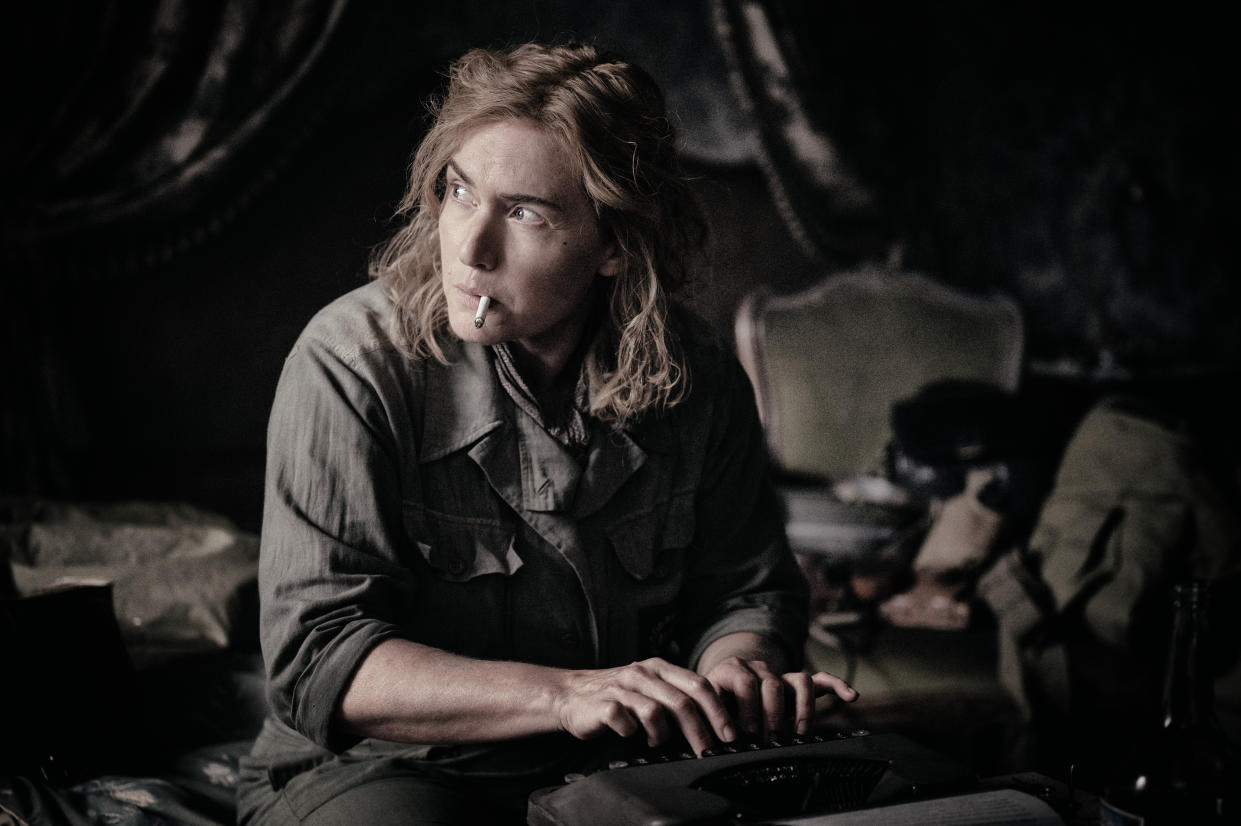‘Lee’ Review: Kate Winslet Stars as an Iconic WWII Photographer in This Uninspired Biopic

- Oops!Something went wrong.Please try again later.
If there were an award for the most cinematic cigarette-sucking on film, “Lee” would be a shoo-in. Over the course of the nearly two-hour biopic, Kate Winslet, who stars as the war photographer Lee Miller, is consistently depicted amid a cloud of smoke, satisfying her oral fixation. Sometimes she puffs urgently, seeking to ease her jittery anxiety. In other scenes, she takes her time, her dramatic drags and pregnant pauses signaling that this lady has seen some things, kept some secrets, and survived it all.
Directed by the legendary cinematographer Ellen Kuras, “Lee” is one of the most conventional biopic exercises this year. The film is framed by a long conversation in 1977 between an elderly Lee (Winslet in makeup) and a young journalist, Antony (Josh O’Connor), seeking to chronicle Lee’s life. The pair chat in a moodily lit living room, Antony hunched over piles of Lee’s old photographs as the photographer, reclined across from him, narrates periods of her life while drinking whiskey and, of course, chain smoking.
More from IndieWire
Talks Between WGA and AMPTP Are Expected to Resume Next Week
Taika Waititi and Billy Luther Set Out to Make Indigenous Stories Feel Less 'Alien'
She begins her life story in 1938, when she was living in France and reveling in long days of sunshine, sex, and drinking alongside her best friends Nusch Eluard (an underused Noémie Merlant) and Solange D’Ayen (an even more underused Marion Cotillard). It’s there, lounging topless outside a picturesque estate, that she meets Roland Penrose (Alexander Skarsgard), who soon woos her and whisks her away to build a life in London. Flash forward to 1940, when Lee scores a plum job as a photojournalist at Vogue, working under British editor Audrey Withers (Andrea Riseborough, as chameleonic as ever) as well as the icier Cecil Beaton (Samuel Barnett).
As the screenplay, written by Liz Hannah (“The Post”), John Collee, and Marion Hume, plods onward, many of its sequences are pegged to specific photos from Lee’s real-life body of work. When Lee walks up to the Vogue offices during the Blitz in 1941, she is inspired to photograph a couple of employees in fire masks, squatting in the entrance to an air-raid shelter. (The real photograph, along with many others recreated in “Lee,” appears during the film’s credits.)
“Lee” eventually darkens considerably, after its protagonist grows restless on the sidelines and longs to become a war correspondent in the field. She secures credentials, and the remainder of the film tracks her travels alongside her friend and fellow photographer David Scherman (Andy Samberg) as they capture the atrocities in Germany.
Clunky narration detracts somewhat from the power of these scenes — “even when I wanted to look away, I knew I couldn’t,” the 1977 Lee tells her interlocutor at once point — but Winslet and Samberg build a genuine rapport, and their characters’ dedication to capturing history in real time lends some vitality to a narrative that frequently threatens to lapse into inertia.
While watching “Lee,” I often longed for more ferocity, both in the filmmaking choices and in the performances. There is something depressing about seeing Kuras — whose brilliant and disruptive work on Michel Gondry’s “Eternal Sunshine of the Spotless Mind” helped cement the movie in the annals of film history — saddled with such a prosaic project.
Like Kuras’ cinematography work, Lee Miller’s real-life photography is celebrated for being bold, surreal, and iconoclastic. By taming that unruliness for the screen, “Lee” squanders that raw power. “I’d rather take a picture than be one,” Lee remarks to Antony early on in the movie. This biopic openly defies that wish, and though it is not an unpleasant experience, it is a limp one.
Grade: C
“Lee” premiered at the 2023 Toronto International Film Festival. It is currently seeking U.S. distribution.
Best of IndieWire
Sign up for Indiewire's Newsletter. For the latest news, follow us on Facebook, Twitter, and Instagram.

